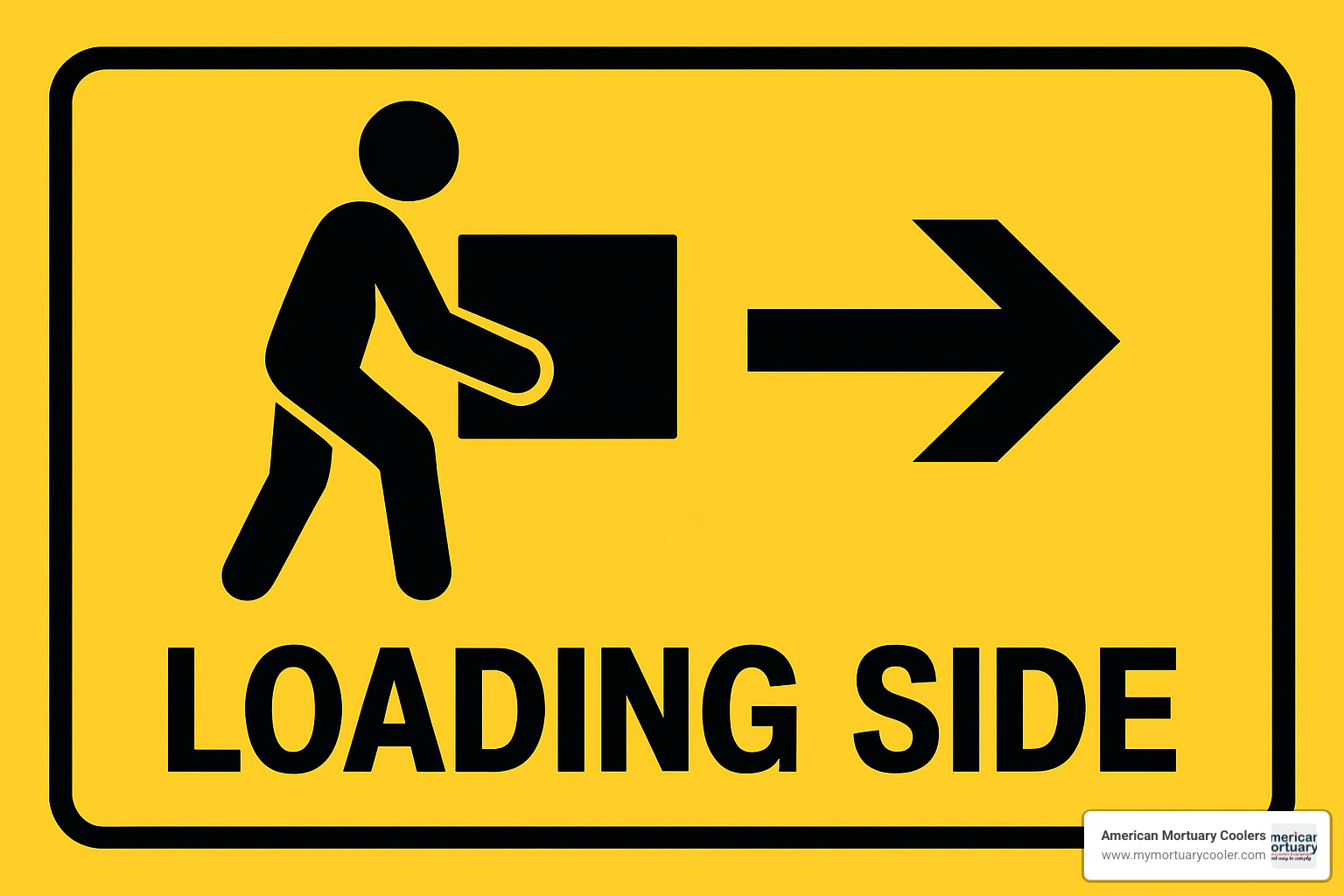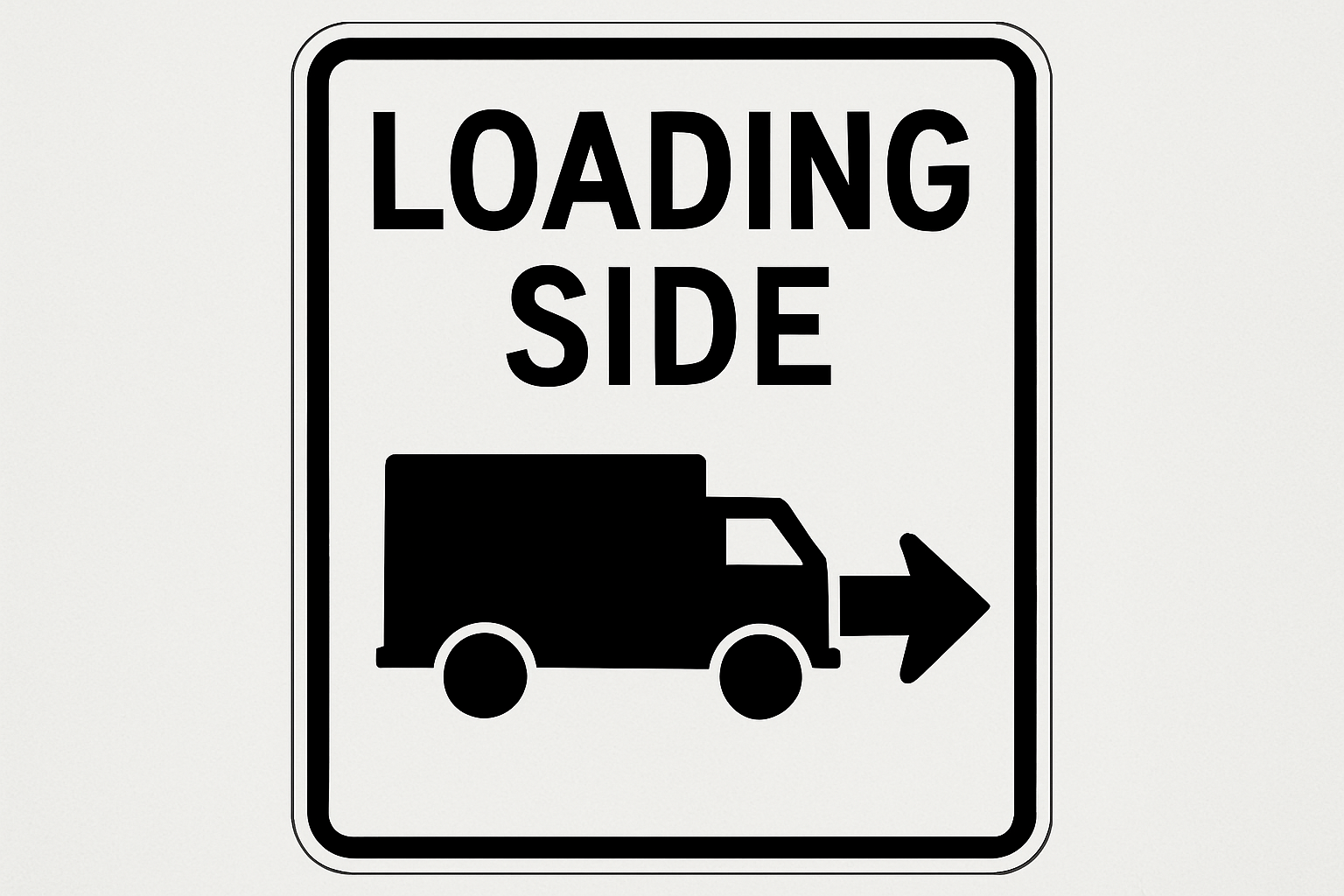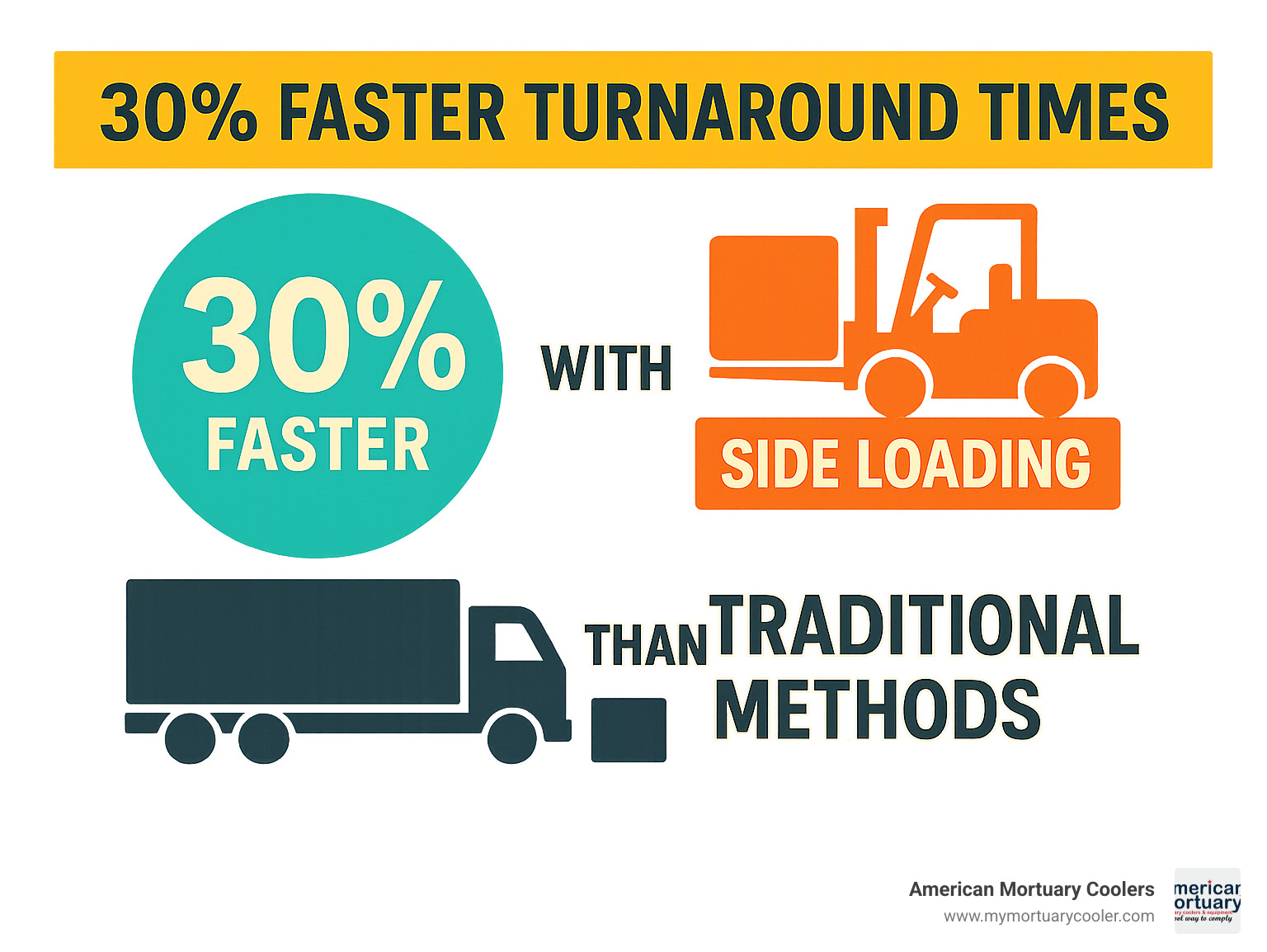
Loading Side Meaning: Terms Demystified
Understanding the Loading Side: A Critical Logistics Concept
The term loading side refers to the method of loading and unloading cargo from the side of a vehicle rather than from the rear or top. This approach is particularly valuable when handling oversized or bulky items that cannot easily fit through standard rear doors, or when operating in spaces with limited access.
What is loading side?
- Definition: The process of loading/unloading cargo from the side of a transport vehicle
- Primary uses: Handling oversized cargo, operating in tight spaces, improving warehouse efficiency
- Equipment: Side-loading forklifts, telescopic forks, skate & track systems, cranes
- Industries: Logistics, warehousing, funeral services, manufacturing
Loading side techniques have evolved significantly over the decades, changing from purely manual methods to sophisticated automated systems. When implemented correctly, side loading can reduce loading and unloading times by up to 30%, allowing companies to handle additional trucks per hour.
For mortuary and funeral home operations, side loading is especially valuable when maneuvering trays in cooler rooms with space constraints. The ability to load from the side often eliminates the need for extensive turning space that end-loading would require.
I'm Mortuary Cooler, a national-level supplier of mortuary storage solutions with extensive experience designing side-loading roller systems that maximize space efficiency in funeral homes and crematoriums. My work with loading side configurations has helped numerous facilities improve workflow and reduce staff strain during transfers.

Loading Side: Definitions Across Industries
You might be surprised to learn that loading side means different things depending on who you're talking to. While we're mostly focused on the physical side-loading of items in the funeral industry, it's fascinating to see how this concept appears across various fields—each with their own unique twist.
| Industry | Loading Side Definition | Primary Equipment | Key Concerns |
|---|---|---|---|
| Logistics | Physical cargo loading from vehicle side | Telescopic forks, sideloaders | Space utilization, efficiency |
| Engineering | Radial force on actuator components | Bearing supports, alignment tools | Component wear, precision |
| Technology | Installing apps from unofficial sources | APK files, developer tools | Security, compatibility |
| Cybersecurity | Exploiting DLL search paths | Malicious code, verification tools | Threat detection, prevention |
Loading Side in Logistics
In warehouses and shipping, loading side simply means accessing cargo from the side of a vehicle rather than the back. It's a practical solution that's been refined over decades.
"Side loading is the way by which goods are loaded and unloaded on/from a transport vehicle from the side rather than from the rear," as industry experts often explain. This approach shines when traditional rear loading just isn't practical.
You'll commonly see this method used with vehicles specifically designed for the task:
Curtainsiders feature fabric sides that completely open up, making them perfect for side access. Sideloader trucks take this a step further with built-in cranes designed specifically for lateral loading. Even standard trailers can be adapted for side loading when paired with specialized equipment like telescopic forks.
Here at American Mortuary Coolers, we've taken these logistics principles and custom them for funeral homes. Our roller systems allow for smooth side loading of cadaver trays in tight spaces, bringing efficiency to facilities across Tennessee, Georgia, and nationwide. It's amazing how principles from one industry can be thoughtfully adapted to improve workflows in another.
Loading Side in Cybersecurity
On the completely digital side of things, loading side takes on an entirely different meaning. In cybersecurity circles, "sideloading" refers to two main concepts:
The first is something many smartphone users have encountered—installing apps from somewhere other than official app stores. This might be downloading an APK file directly to an Android device, for example.
The second is more concerning. As one security expert puts it: "DLL side-loading is a popular technique used by threat actors to circumvent security solutions and trick the Windows operating system into executing malicious code on the target endpoint."
This happens because Windows follows a specific search order when looking for DLL files. Clever attackers exploit this by placing harmful files in locations that Windows will check before finding the legitimate versions.
While this digital form of loading side seems worlds apart from moving physical objects in a mortuary, understanding these different definitions helps prevent confusion when professionals from different fields discuss their work. After all, clarity in communication is essential whether you're designing a mortuary cooler system or protecting digital assets.
Methods & Equipment for the Loading Side in Warehousing

When it comes to loading side operations, having the right tools makes all the difference. Over the years, I've seen how the proper equipment transforms what used to be backbreaking work into smooth, efficient processes.
The warehouse industry hasn't been sitting still – decades of innovation have given us specialized tools that make side loading not just possible but often preferable to traditional methods.
Key Equipment for Side Loading
The heart of effective loading side operations are the tools designed specifically for lateral access. Telescopic forks (often called ReachForks) are game-changers – these hydraulically extendable forks reach deep into trailers from the side, eliminating the need to reposition vehicles. Many of our clients tell me these alone reduce loading times by about 30%, often allowing them to handle an extra truck every hour.
Side-loading forklifts are another essential piece of equipment. Unlike traditional forklifts, these are designed to carry long loads parallel to their direction of travel – perfect for those awkward items that would be impossible to maneuver otherwise.
For facilities with specific needs, skate and track systems provide floor-mounted solutions that make moving heavy items sideways much easier. In our mortuary applications, we've found that roller bar racks with industrial-grade castors and 1.9" gravity-free rollers make a world of difference when side-loading cadaver trays in tight spaces.
For larger operations, automated loading systems, conveyors, and strategically placed cranes and hoists complete the side-loading toolkit. Many of our funeral home clients are surprised at how these warehouse technologies can be adapted to their unique needs. Learn more about our Efficient Mortuary Cadaver Lift with multi-directional capabilities.
Loading Side for Bulky & Oversized Goods
This is where loading side truly shines. When you're dealing with long materials like lumber or structural steel, trying to load from the rear is like trying to parallel park a bus in a compact spot – technically possible but not worth the headache.
The same goes for industrial machinery and other awkwardly shaped cargo that simply won't fit through standard rear doors. I remember one client who switched to side loading for their oversized equipment and eliminated what had been a daily frustration for their team.
One of my favorite applications is multiple pallet handling. Loading two pallets simultaneously from the side can boost efficiency by up to 65% compared to single pallet movements. That's not just a small improvement – it can mean handling five additional trucks per shift.
For our mortuary clients with limited space, we've found that cantilever racking combined with side-loading systems maximizes every square foot while keeping workflows smooth and dignified.
Automated Systems Boosting Loading Side Efficiency
The future is already here when it comes to loading side automation. Moving floor systems with sections that automatically shift cargo in and out are revolutionizing high-volume operations. Slipchain technology uses chain-driven systems to pull pallets in from the side, while trailerskate systems can load an entire trailer in minutes with minimal human intervention.
Smart warehouses are now incorporating IoT-enabled sensors that monitor and coordinate loading operations in real-time. One distribution center manager told me, "These systems not only reduced our labor requirements but actually improved safety metrics across the board."
The beauty of automation is how it scales to different needs. For some of our smaller funeral home clients, simple roller systems provide just enough automation to make a meaningful difference in their daily operations. For larger facilities, we can design comprehensive systems that transform their entire workflow.
Whether you're handling lumber or managing a mortuary, the right loading side equipment isn't just about efficiency – it's about making difficult tasks manageable and keeping your team safe in the process.
Benefits, Drawbacks & Safety Best Practices

When it comes to loading side techniques, there's a clear balance of advantages and challenges that every facility needs to consider. Having worked with funeral homes across Tennessee and beyond, we've seen how the right approach can transform operations.
Key Benefits of Loading Side Operations
The efficiency gains from loading side operations can be truly impressive. Many of our clients report up to 30% faster loading/unloading times after switching to side-loading systems. This time savings adds up quickly in busy facilities.
A logistics manager from a distribution center in Dallas shared with us: "Since implementing side loading with telescopic forks, we've been able to handle two additional trucks per shift. The return on investment was achieved within just six months."
Beyond speed, side loading shines in tight spaces where traditional end loading just isn't practical. For many funeral homes with limited square footage, the ability to load from the side means they can maximize their available space without costly facility renovations.

Potential Drawbacks and Risks
Of course, no system is perfect. Loading side approaches do come with considerations that facilities need to address. Load shifting can be more common with side-loaded cargo, requiring extra attention to proper securing techniques. The specialized equipment needed—whether telescopic forks or roller systems—represents an upfront investment, though one that typically pays for itself quickly through operational efficiencies.
Safety concerns are also paramount. Side loading creates different traffic patterns around vehicles that can increase pedestrian collision risks if not properly managed. This is why we always emphasize comprehensive training when installing our roller systems in mortuary facilities.
Safety Best Practices for Loading Side
Safety isn't just a checkbox—it's a culture that needs to permeate every loading side operation. The Health and Safety Executive provides excellent guidance on safe loading procedures that we recommend to all our clients.
The basics start with creating a protected workspace. Always cordon off the operating area around the truck when performing side loading to prevent anyone from walking into harm's way. Vehicle control is equally important—we recommend obtaining the keys from drivers before beginning operations to prevent premature departures.
Stable footing makes all the difference in safe operations. Always park on firm, level ground with no debris before starting any loading procedure. This simple step prevents countless accidents.
In our mortuary roller systems, we build safety into every component. Our anti-corrosive powder coat finishing isn't just about looks—it improves durability in demanding environments. The industrial-grade castors we install come with locking mechanisms that prevent unwanted movement during critical loading operations.
When is Loading Side Preferred?
Through our years of experience at American Mortuary Coolers, we've identified several scenarios where loading side is clearly the best choice:
Urban facilities without rear docks often find side loading to be their only viable option. The same goes for kerbside deliveries in congested city areas where backing up to a dock simply isn't possible.
When handling oversized items that exceed standard rear door dimensions, side loading becomes necessary rather than optional. This is particularly relevant in mortuary settings where specialized equipment needs to be moved in and out of cooler rooms.
Space constraints drive many of our clients to side-loading solutions. In typical mortuary facilities, especially older buildings, the clearance needed for end-loading simply doesn't exist. Our side-loading roller systems allow for efficient movement of cadaver trays without requiring extensive turning space.
Key Safety Rules for Loading Side Operations
Consistent safety protocols make all the difference in loading side operations. Always keep vehicle keys or paperwork until it is safe for the vehicle to depart. This simple control measure prevents countless accidents.
Visual communication can prevent dangerous misunderstandings. Many facilities use traffic lights and trailer restraints to clearly signal when drivers should remain stationary. These visual cues work across language barriers and in noisy environments.
Personal protective equipment might not seem exciting, but it saves lives and prevents injuries. Proper footwear with reinforced toes, high-visibility clothing, and appropriate gloves should be non-negotiable for loading personnel.
Always perform stability checks before unloading to verify that nothing has shifted during transport. This quick assessment prevents surprise load shifts that could injure staff or damage cargo.
By combining these safety practices with the right equipment, facilities can enjoy all the efficiency benefits of side loading while keeping their team members safe. At American Mortuary Coolers, we're committed to helping funeral homes implement these best practices with every system we install.
Loading Side Beyond Warehouses: Tech, Engineering & Security

While we've spent time exploring physical loading side operations in warehouses, it's fascinating how this concept stretches into other technical fields. The parallels might surprise you – and understanding them gives us a more complete picture of this versatile concept.
Loading Side in Technology
Ever installed an app that didn't come from the official app store? That's technology's version of side loading. When developers send you an app to test before release, or when you download an app not available in your region, you're engaging in a digital form of loading side.
"Sideloading is essentially bringing content in through the side door," as one tech expert puts it. Instead of the front-facing official channels, you're accessing software through an alternative path.
The process typically involves downloading APK files for Android or IPA files for iOS, then enabling "Unknown Sources" in your device settings. For businesses, this approach offers valuable flexibility – allowing custom enterprise apps to be distributed directly to employees without going through public app stores.
At American Mortuary Coolers, we understand the value of flexibility. Just as our custom mortuary solutions adapt to unique facility needs, technology sideloading adapts to specific user requirements when standard channels don't quite fit.
Loading Side in Linear Actuators
Engineers have their own take on loading side – and it's all about forces and alignment. When working with linear actuators (those mechanical devices that create motion in a straight line), side loading becomes a critical concern.
"Think of it like trying to push a drawer closed from an angle instead of straight on," explains one engineer. "That sideways pressure creates wear that wouldn't happen with proper alignment."
In technical terms, side loading occurs when force is applied radially (from the side) rather than along the actuator's axis of extension. This misalignment causes components to rub against each other, creating friction and wear. Over time, this can damage gears, prevent smooth operation, and significantly shorten the actuator's lifespan.
For facilities using automated equipment – whether it's a warehouse conveyor or a mortuary lift system – understanding these engineering principles helps extend equipment life and prevent costly breakdowns.
Protecting Against Malicious Loading Side Attacks
Perhaps the most concerning application of loading side concepts comes from cybersecurity, where DLL side-loading represents a genuine threat to system integrity.
This attack method exploits how Windows searches for dynamic link libraries (DLLs) – the shared code that applications use. When Windows looks for a specific DLL, it checks multiple locations in a predetermined order. Attackers place malicious files with legitimate names in locations that Windows checks first, tricking the system into loading harmful code.
"It's like someone intercepting your mail and replacing it with something that looks identical but contains something harmful," describes one security professional. "Your system thinks it's getting legitimate instructions, but it's actually executing malicious code."
To protect against these attacks, organizations should implement several key safeguards:
Signature verification ensures only properly signed code executes, while restricted directory access prevents unauthorized file placement. Organizations should also deploy endpoint detection tools to identify suspicious loading patterns, and provide clear user training about the risks of running untrusted software.
Microsoft provides detailed guidance on preventing these attacks through their DLL mitigation tips, which include secure coding practices and system hardening recommendations.
At American Mortuary Coolers, we recognize that modern funeral facilities increasingly rely on connected systems for inventory management and tracking. That's why our consultations include guidance on securing both physical equipment and digital operations – ensuring your facility runs smoothly on all fronts.
Understanding loading side in these varied contexts highlights an important truth: whether we're talking about moving physical objects, managing mechanical forces, or securing digital systems, similar principles of access, alignment and security apply across disciplines.
Frequently Asked Questions about Loading Side
What makes loading side faster than rear loading?
When it comes to efficiency, loading side operations often leave traditional rear loading in the dust. The speed advantage isn't just marketing talk – it comes from practical advantages that warehouse managers see every day.
Think about how loading side gives you access to the entire length of a trailer at once. Your forklift operator can see everything, reach everything, and work with a complete view of the cargo space. With telescopic forks, they can often grab two pallets at once, essentially doubling productivity without doubling effort.
I've spoken with distribution center managers who've told me, "Since switching to side loading, we've cut our loading times nearly in half." The numbers back this up too – industry data shows efficiency can jump by as much as 65% when handling multiple pallets simultaneously with telescopic forks. That translates to handling five additional trucks per shift in some operations.
For our mortuary clients, this efficiency means staff spend less time on transfers and more time on compassionate care. The side-loading roller systems we install at American Mortuary Coolers allow for quick, dignified transfers even in facilities where space comes at a premium.
How does loading side differ from sideloading apps?
It's funny how the same term can mean completely different things depending on who you're talking to! While both concepts involve accessing something from the "side," they couldn't be more different in practice.
In the logistics world, loading side is all about the physical movement of goods – using specialized equipment like telescopic forks to load cargo through the lateral sides of vehicles. It's hands-on work focused on moving tangible items efficiently and safely.
Meanwhile, if you're chatting with a tech person about "sideloading," they're talking about installing apps from somewhere other than official app stores. This might involve downloading APK files on Android or using special tools on iOS, after enabling permissions that are often hidden in settings menus.
The connection? Both involve accessing content through non-standard channels – but that's where the similarities end. One deals with boxes and pallets; the other with code and digital permissions. One requires forklifts; the other requires clicking "Allow installations from unknown sources" in your settings.
At American Mortuary Coolers, we focus on the physical kind of loading side – the kind that helps funeral homes manage space constraints and improve workflow, not the kind that puts new games on your phone!
What equipment is mandatory for safe loading side in tight spaces?
Safety should never be compromised, especially when working in confined areas. For effective loading side operations in tight spaces, having the right equipment isn't just convenient – it's essential.
Telescopic forks top the list because they extend deep into trailers without needing space on both sides of the vehicle. This is a game-changer for facilities with limited maneuvering room. Good visual aids are equally important – mirrors or cameras help operators see what's happening in blind spots, preventing accidents before they happen.
Proper lighting throughout the loading zone is non-negotiable. I've visited facilities where dim lighting contributed to near-misses that could have been easily avoided. Combined with clear communication devices between operators and drivers, good visibility keeps everyone on the same page.
In the mortuary setting, we've refined our recommendations based on years of experience. Our roller racks come with industrial-grade castors featuring reliable locking mechanisms to prevent unexpected movement. We also emphasize anti-slip surfaces on roller bars, clear floor markings, and ergonomic handles that make manual guidance less physically demanding.
As one loading safety expert told me, "The safest way to carry a load is if it's distributed as evenly as possible with the center of gravity as low and as close to the center line as possible." This principle holds true whether you're moving pallets of merchandise or providing dignified care in a funeral home.
At American Mortuary Coolers, we design our side-loading systems with both efficiency and safety in mind, knowing that in tight spaces, there's simply no room for error.
Conclusion
The concept of loading side represents a versatile approach to cargo handling that offers significant advantages in efficiency, accessibility, and versatility across multiple industries. From logistics warehouses to mortuary facilities, the ability to load from the side rather than exclusively from the rear opens up new possibilities for space utilization and operational improvement.
When you think about it, loading side techniques have transformed how we handle everything from lumber to cadavers. The numbers speak for themselves – with side loading reducing loading and unloading times by up to 30%, businesses can handle more deliveries without expanding their workforce or facilities.
At American Mortuary Coolers, we've seen how these principles make a real difference in funeral homes and crematoriums. Our customers tell us that the roller bar rack systems we design specifically for side loading have dramatically improved their daily operations, especially in those older buildings where space comes at a premium.
Safety always comes first in side-loading operations. We emphasize proper training, clear communication protocols, and equipment designed with safety features built in. When implemented correctly, these measures not only prevent accidents but also protect your valuable cargo and equipment from damage.
What's fascinating is how the concept extends beyond physical goods movement. The term takes on new meanings in technology and engineering contexts, reminding us that innovation often crosses industry boundaries in unexpected ways.
For mortuary professionals working in confined spaces, our custom-designed side-loading solutions have proven particularly valuable. The ability to smoothly transfer deceased loved ones without awkward maneuvering helps maintain the dignity that families expect during their time of loss.
We deliver our mortuary coolers and roller systems directly to facilities across the contiguous 48 states from our Tennessee headquarters. Whether you're operating in the Southeast, Midwest, or along the Pacific coast, we understand the unique challenges your facility faces and can customize solutions accordingly.
The return on investment for proper side-loading equipment is substantial. Beyond the immediate efficiency gains, many of our clients report reduced staff fatigue, fewer workplace injuries, and extended equipment lifespan when using properly designed systems.
For more information about custom mortuary storage solutions that incorporate efficient side-loading designs, contact American Mortuary Coolers today. Our expertise in creating durable, custom equipment has helped countless facilities optimize their operations while maintaining the highest standards of dignity and care.



